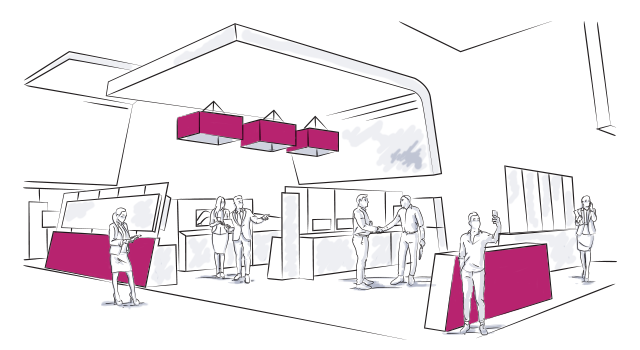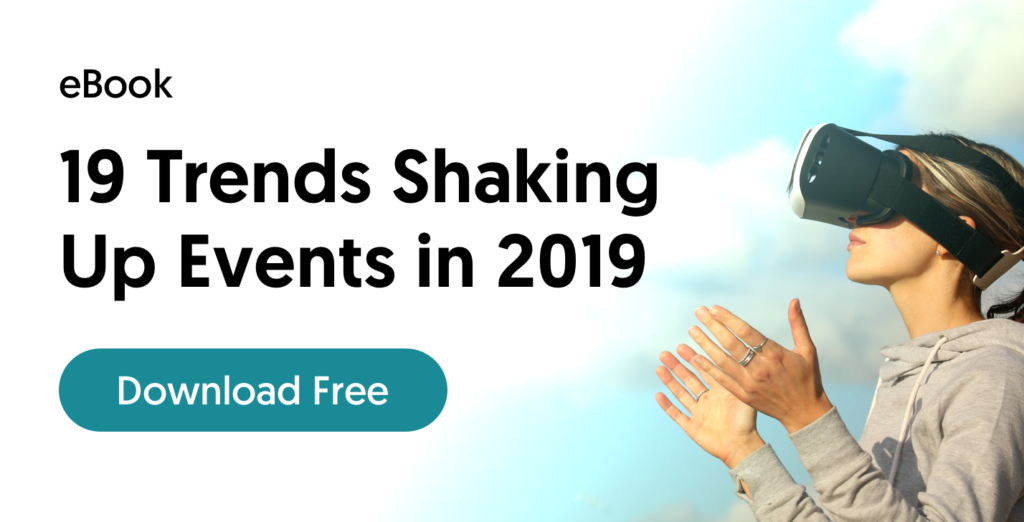
Tech Thursday: Everything You Need to Know About Augmented Reality Event Planning
Did you know that 88% of event planners were making arrangements to host virtual reality (VR) events last year? And 87% of them planned some sort of augmented reality (AR) event too. Clearly virtual event planning is in high demand right now.
Whether you’re new to event tech or you’re looking for inspiration for that next big VR and AR event, we’ll break down everything you’ll need to know to feel confident about having this skill on your resume.
Augmented Reality (AR) vs Virtual Reality (VR)
Augmented reality is a hardware filter we can use to see our world but with an image, sound, or effect on top of it. It’s most commonly used through apps on smartphones. Virtual reality, on the other hand, is a totally immersive experience that often requires a full headset and controller system to enjoy.
Both technologies have become more popular thanks to the pop culture and gaming spheres. Whether its an entire AR/VR event or just an event with AR/VR elements, there’s lots to gain from including the latest technology in your event planning strategy.
How to use Augmented Reality and Virtual Reality for Events
The tools that have already come out using VR and AR for event planning are very promising. And they can be used before, during, and after any event to aid your event planning process and wow your guests on the actual day. Here are a few ways you can incorporate this technology into your events today:
- Train your event staff and planning team. Brands like Mercedes Benz create 3D model videos to train their employees at every level.
- Showcase sponsorship packages. The sports industry has already embraced immersive tech with companies like Coca-Cola using it to advertise at hundreds of major events worldwide.
- Take advantage of fully immersive trips. Sites like Cvent’s Supplier Network let you explore interactive floor plans for venues worldwide and other such as Virtual Fam Trip have a global database of event venues you can tour without ever leaving your office. Some facilities that are under construction today might even have tours available for what their soon-to-be-built event space will look like.
- Speed up the RFP process. Virtual reality also make it easier for venue managers to reach out to event planners as well as vendors and show them the insides of their space, using tools such as Social Tables photo-realistic 3D diagramming.
- Adopt an AR app that drives event traffic. For example, apps like Google’s ARCore let guests interact with trade show booths and branded conferences in whole news ways through elements like educational pop ups and customizable games. Advertise these features ahead of time to help push ticket sales.
All in all, getting ahead of the curve on these two key trends will help impress clients and partners, while also making your job easier at the same time!
New Ways to Get the Most from Virtual/AR During Events
This technology makes for very a impressive addition to everything from birthday parties to high profile meetings to trade shows. Here’s just a taste of what you can do:
- Offer lightweight and affordable entertainment. Visual effects glasses like the kind made by Hi-Lites can turn any light into custom shapes and doesn’t require an investment in complex equipment.
- Use branded hashtags and filters for high ROI social media content. Companies like SnapChat are already doing this very successfully but you can always create your own branded experience through photo and video options with a little help from AR.
- Tell stories about your brand or the origin of your products. You can use any VR equipment to tell a relevant story that all at once invites the viewer to be an active participant while also forming an emotional bond – which is what all great events do for their guests!
- Offer post-event access to event content. Experts say that because the average consumer has access to products like Google Cardboard and the Oculus Rift, they can enjoy your immersive experiences even after they leave your booth or venue.
- Install trust in your customer base through product demonstrations. Whether it’s a tour, a model, or an experience, pretty much anything can be recreated through VR. Seeing might still be believing but in this case your audience will get to see, hear, touch, and try out a wide range of offerings that would have never been possible otherwise.
The only limitations to virtual reality and augmented reality in event planning lie in your own imagination. These tools can be used in all facets of the event planning process. From inception to creation, VR and AR have proven to be welcome event additions for both the companies who use them and the attendees who benefit from them.
But don’t just take our word for it, check out these great examples from real life events featuring virtual/AR event planning.
5 Augmented Reality & Virtual Reality Event Ideas From Leading Brands
There are plenty of AR and VR events you can attend that will inspire your own. But if you’re looking for some quick examples to get you started, you can use any of these as a jumping off point for your own ideas.
As you’ll soon find out, virtual reality and augmented reality is far more accessible for event planning than you may have guessed. And the appeal is far reaching – even senior living facilities have found great uses for them!
As long as you create content that is relevant to your audience and your brand, any virtual/AR event planning effort is sure to be a success. Here are five killer examples that prove it:
1. Patron’s Virtual Reality Behind the Scenes Experience
In an effort to bring that wow factor to their booth at recent trade show and conference events, the famous liquor brand went above and beyond to include some well made content for their immersive experience. The 2 minute and 40 second video example shows an animated story of the how the product gets made. From the agave fields to the glass, Patron does an excellent job of creating a charming emotional connection with its audience and telling an entertaining story.
Main Takeaway: Adding on brand storytelling elements to your VR content make it more fun and memorable.

2. Mercedes’ Immersive Mountaintop Adventure
For Mercedes, it’s all about showing off what experiences their customers can have once they invest in their vehicles. In this immersive event experience example, the luxury car brand shared an exciting 360 degree experience of one Mercedes owner’s mountain explorations with his trusted dog Loki at his side.
Main Takeaway: Because AR and VR is all about creating an experience, you should focus on sharing event content that is relevant to the theme as a whole while also creating something entirely unique for the viewer.
3. Unite LA’s Surprise Art Exhibit
Over a series of conferences, Unite LA provided guests with the opportunity to view unique and imaginative art work in a captivating way through the help of AR. After downloading the event app, attendees could use the platform to view the full extent of the gallery, magically turning barren pedestals into extravagant displays and plain, 2D posters into pop out experiences.
Main Takeaway: Even if you’re not interested in telling a story, you can display cool images, models, and products through your very own event app which helps you get the most out of the tool while also engaging attendees in a fun, new way.
4. Intel’s Innovative Press Conference at CES 2017
CES is all about showcasing innovative tech and Intel’s presentation in 2017 is no exception. Part product launch, part press conference, part thrilling exploration, Intel gave attendees the opportunity to try their VR hardware during the keynote. Following along with the speaker, guests viewed: basketball games from courtside seats, alien spaceships, and zombie apocalypses.
Main Takeaway: Even if your event is part of a larger experience, you can take any traditional lecture format and turn it into a hands on experience without attendees ever having to leave their seats. It just goes to show that VR and AR can be integrated into all aspects of event planning, no matter what they traditionally look like.
5. LiveNation’s Meet the Band
Fans of Imagine Dragons were treated to a special live VR experience when LiveNation provided guests with exclusive backstage access. If you have some superstars lined up for your next event, you can easily duplicate the interview/VR format to create something original of your own. And the best part is that content can be captured and repurposed for other marketing campaigns in the future, making it both a special immersive experience and evergreen content all in one.
Main Takeaway: If you plan to include livestream in your next event plan, consider setting up your cameras to film the experience for VR content.
Improving Events with Augmented Reality and Virtual Reality Can Be Easy
Now that you know what these two great technologies are and how to use them in your event planning and/or execution, you should feel well equipped to integrate them more and more in the coming years. As you continue to use virtual/AR in event planning, keep these key points in mind:
- Virtual reality and AR event planning is all about creativity – both in terms of the content you share and the ways in which you use the technology. Don’t be afraid to add VR and AR to event elements you haven’t seen them used in before – we are just beginning to see what they can do, and pioneering is extremely encouraged at this stage.
- VR and AR events and event elements are as practical as they are entertaining. From boosting sales to training customer service reps, this tech is surprisingly versatile. Make sure you use it to the fullest by aligning your tools with your event goals.
- Look to leading brands and events for more inspiration. There are more and more VR and AR themed events in the works than ever before. Make sure you keep up with industry news and check out a few of these great get togethers so you can see what’s already being done.
VR and AR are also changing the way we conduct virtual events while also facilitating the latest trends in experiential marketing. Which just goes to show – the sky really is the limit with virtual/AR event planning!
